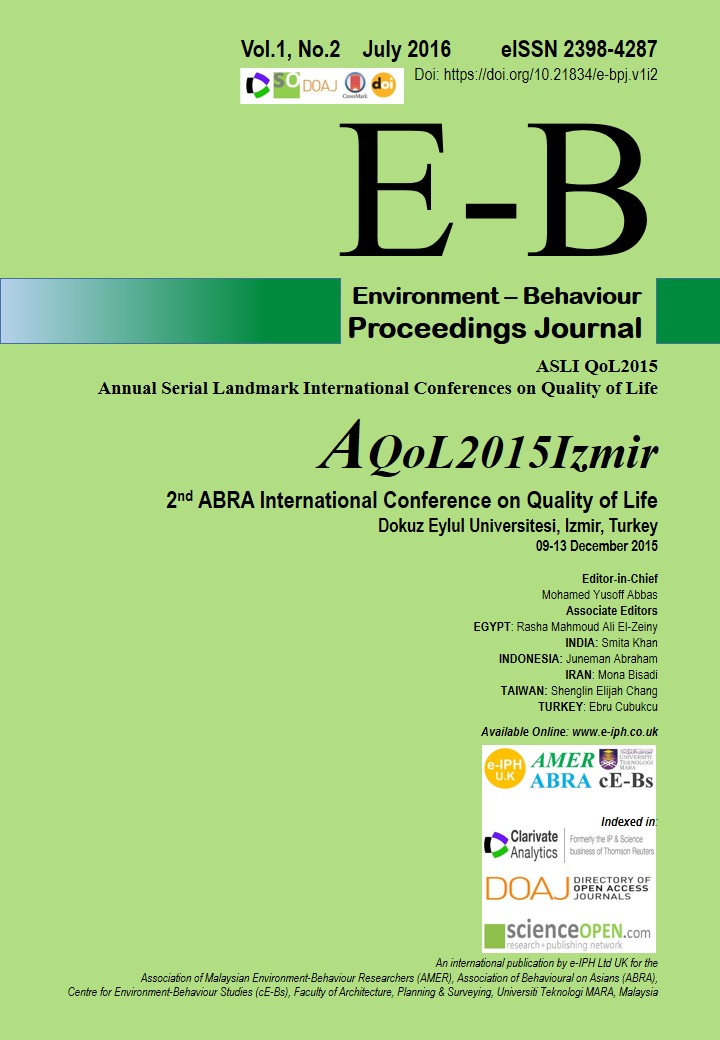Evaluating Multi-dimensional Human Needs in Open Spaces: Taman Tasik Shah Alam, Selangor, Malaysia
DOI:
https://doi.org/10.21834/e-bpj.v1i2.259Keywords:
Open Spaces, Physical Health, Outdoor Urban Environment, Human InteractionAbstract
The paper aims to provide valuable insight of the various dimensions of human needs' and their perceived benefits towards open spaces. This study employed a mixed method research design involving both quantitative and qualitative methods that were utilised to identify and evaluate the human-human interaction and human-nature interaction in the area of study. Primary data was gathered by using questionnaire survey that administered to 428 respondents as visitors to a public park. The finding of this study is intended to show the main domains that reflect human needs' toward open spaces together with perceived benefits to the open spaces users.
References
Chiesura, A. (2004). The role of urban parks for the sustainable city. Landscape and Urban Planning, 68(1), 129-138. doi:10.1016/j.landurbplan.2003.08.003. DOI: https://doi.org/10.1016/j.landurbplan.2003.08.003
Department of Town and Country Planning, Selangor (2004). National Physical Plan. Ministry of Housing and Local Government Malaysia, Malaysia.
Illia, F., Omar, D., & Hanita, N. (2013). Human interaction in open spaces, (December), 17-18.
Illia, F., Omar, D., & Hanita, N. (2014). Theoretical review on sustainable city indicators in Malaysia, 04.
Marzukhi, M. A., Karim, H. A., & Latfi, M. F. (2012). Evaluating the Shah Alam City Council Policy and Guidelines on the hierarchy of neighborhood open space. Procedia - Social and Behavioral Sciences, 36(June 2011), 456-465. doi:10.1016/j.sbspro.2012.03.050 DOI: https://doi.org/10.1016/j.sbspro.2012.03.050
Machabee, L. G., Oleson, J. J., Kinzig, A. P. (2005). Neighborhood parks uses by phoenix residents: An exploration of socio demographic differences. People, Places, and Parks: Proceedings of the 2005 George Wright Society Conference on Parks, Protected Areas and Cultural Sites. Hancock, Michigan: The George Wright Society.
Matsuoka, R. H., & Kaplan, R. (2008). People needs in the urban landscape ¯: Analysis of landscape and urban planning contributions, 84, 7-19. doi:10.1016/j.landurbplan.2007.09.009. DOI: https://doi.org/10.1016/j.landurbplan.2007.09.009
Mutiara, S., & Isami, K. (2012). Characteristic of public small park usage in Asia Pacific Countries' ¯: Case study in Jakarta and Yokohama City, 35(December 2011), 412-419. doi:10.1016/j.sbspro.2012.02.106. DOI: https://doi.org/10.1016/j.sbspro.2012.02.106
Omar, D., Illia, F., & Hanita, N. (2015). Human interaction in open spaces, 01, 1-9.
Philips, L.E., (1996). Parks: design and management,United States of America: McGrawHill.
Rasidi, M. H., Jamirsah, N., & Said, I. (2012). Urban green space design affects urban residents' social interaction. Procedia - Social and Behavioral Sciences, 68(November), 464-480. doi:10.1016/j.sbspro.2012.12.242. DOI: https://doi.org/10.1016/j.sbspro.2012.12.242
Shuib, K.B. (2008). Context, concept and purpose of park and protected areas, Shah Alam: Recreational Park Planning.
Downloads
Published
How to Cite
Issue
Section
License
Copyright (c) 2016 Dasimah Omar, Filzani Illia Ibrahim, Nik Hanita Nik Mohamad

This work is licensed under a Creative Commons Attribution-NonCommercial-NoDerivatives 4.0 International License.





